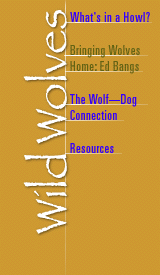 |
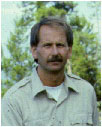 Bringing Wolves Home: Ed Bangs
Bringing Wolves Home: Ed BangsWolf Recovery Coordinator U.S. Fish and Wildlife Service "Wolves are a top-line predator. They have a major influence..."NOVA: I understand you helped direct the program that reintroduced wolves to the United States, after years of extinction. Where did you get the wolves? EB: Well, we needed wolves that knew how to make a living in an area like Yellowstone National Park. And so we began to think about where to get wolves 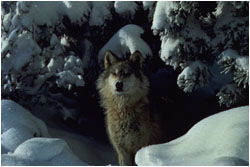 that would know what an elk is, how to find one, and how to kill one—and
where to get wolves that are used to living in cold mountainous terrain. All
you have to do is look north of the border and you find that next to Banff
National Park in Alberta, and a little bit farther north in British Columbia,
you have such wolves. So we contacted the governments of Alberta and British
Columbia and asked if they had any wolves to spare. And they said, "We think
so, but first we'd like you to come up and tag some wolves and do some
preliminary looking to make sure we've got enough." So we did that and sure
enough, there were a lot of wolves. The first year, 1995, we got 29 wolves
from Alberta, and shipped them into Yellowstone and Central Idaho, and the next
year, 1996, we went up to British Columbia and I think we took 37 wolves and
brought them down.
that would know what an elk is, how to find one, and how to kill one—and
where to get wolves that are used to living in cold mountainous terrain. All
you have to do is look north of the border and you find that next to Banff
National Park in Alberta, and a little bit farther north in British Columbia,
you have such wolves. So we contacted the governments of Alberta and British
Columbia and asked if they had any wolves to spare. And they said, "We think
so, but first we'd like you to come up and tag some wolves and do some
preliminary looking to make sure we've got enough." So we did that and sure
enough, there were a lot of wolves. The first year, 1995, we got 29 wolves
from Alberta, and shipped them into Yellowstone and Central Idaho, and the next
year, 1996, we went up to British Columbia and I think we took 37 wolves and
brought them down.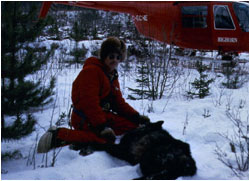 NOVA: How did you catch them?
NOVA: How did you catch them?EB: In Alberta, we worked with local trappers who normally trap wolves for the pelts. We paid them to radio-collar wolves. And then we went in with a helicopter. We had several biologists from the Alaska Department of Fish and Game who are experts at helicopter darting and capture operations. And we had pilots come down from Alaska who are experts at finding wolves by looking at tracks in the snow. We just flew over, found the wolf pack or a radio-collared wolf, then darted the wolves with an immobilizing drug. It takes about seven or eight minutes for the wolf to become immobilized. We put them in dog kennels that we'd established in a provincial park in Canada, fed them road kills and gave them water. When we got enough of them, we flew them on a Forest Service aircraft down to Missoula and Yellowstone. The park guys took family groups and put whole packs in pens in Yellowstone Park, kept them for about two months and then turned loose the family group together. In Central Idaho, we released young adult wolves—essentially teenagers—immediately, without any pens or anything. Both those techniques worked extremely well. NOVA: This is what's know as "hard release" versus "soft release?" |
 of wolf release: RealVideo broadband/dialup QuickTime (1.8MB) AVI (1.8MB) Get video software: RealPlayer QuickTime |
EB: Exactly. Most wildlife reintroductions are hard releases. But in
Yellowstone we thought we had an opportunity to keep wolves in the Park on the
northern range, where there are tens of thousands of elk, as well as keep the
family breeding groups together. NOVA: How strong is a wolf's natural instinct to return home?
NOVA: How strong is a wolf's natural instinct to return home?EB: Real strong. A wolf's territory represents the place where their family lives and where they're safe. If you're in your pack's territory, you have a family to help defend you, to care for you, to share food with you. Wolves are the parents, the mothers, the fathers, the brothers and sisters that we always hoped we could be. I mean there's extreme loyalty among family members, it's everything to them. And if they leave that, then they're exposed to possible attacks by other wolf packs or families. So when you move them somewhere different, they want to go back home. NOVA: How did you deal with this in the context of your relocation project? EB: Well, studies have shown that if you move a wolf more than 60 miles from its home territory, it will try to get back home, but it really can't figure it 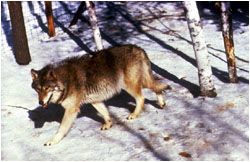 out. They'll go for maybe 30 miles and then think, "Oh man, I'm lost. I don't
have a clue where I'm at." And then they just turn around and go back to where
they started from, trying to re-orient themselves. And what we found in Idaho
was that the wolves generally moved north, in the direction from which they
came, but after a while they figured out, "Man, I'm lost. I don't have a
clue. Nothing looks familiar." And then they just thought, "Well, heck, this
isn't that bad a place. Maybe I'll just set up shop here."
out. They'll go for maybe 30 miles and then think, "Oh man, I'm lost. I don't
have a clue where I'm at." And then they just turn around and go back to where
they started from, trying to re-orient themselves. And what we found in Idaho
was that the wolves generally moved north, in the direction from which they
came, but after a while they figured out, "Man, I'm lost. I don't have a
clue. Nothing looks familiar." And then they just thought, "Well, heck, this
isn't that bad a place. Maybe I'll just set up shop here." NOVA: How did wolves become extinct in America? EB: Well, we deliberately got rid of them, as a society. A hundred years ago, our society placed very low value on all wildlife. We got rid of all the deer, the elk, the bison, the turkeys, you know, everything, in deference to other social objectives, primarily agriculture and settlement. And you can imagine being a grizzly bear or a black bear or a wolf or a coyote—when there was nothing else to eat but livestock, that's what you ate. And as a consequence,  settlers really hated wolves, grizzly bears, and other predatory animals and
they deliberately tried to get rid of them all. The federal government
actually sent out trappers who spent years hunting down the last wolf and
killing it. The last wolves were actually killed by the U.S. Biological Survey,
which is the agency that transformed itself into the U.S. Fish and Wildlife
Service that is now responsible for wolf restoration!
settlers really hated wolves, grizzly bears, and other predatory animals and
they deliberately tried to get rid of them all. The federal government
actually sent out trappers who spent years hunting down the last wolf and
killing it. The last wolves were actually killed by the U.S. Biological Survey,
which is the agency that transformed itself into the U.S. Fish and Wildlife
Service that is now responsible for wolf restoration! NOVA: Weren't biologists concerned about this extermination policy? EB: Well, some people voiced concern, but they were a tiny minority. If you look at politics in the west—it was nothing but farmers and ranchers and settlers who had this strong anti-predator attitude and who were just scraping by. With nothing else to eat, predators were taking their livestock. And so really the voices for restraint were overwhelmed by the vast majority of 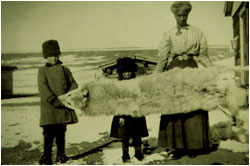 people who wanted to put all the Indians on Indian reservations, cut all the
timber, mine all the dirt, and use all the water. The attitude was
exploitative. You know, it's not good unless a person's using it immediately.
people who wanted to put all the Indians on Indian reservations, cut all the
timber, mine all the dirt, and use all the water. The attitude was
exploitative. You know, it's not good unless a person's using it immediately.NOVA: How did the ecosystems of the Rocky Mountains adjust to the loss of wolves? Were there any indications that they were out of whack? EB: Well, I think the most noticeable thing around Yellowstone Park was, every five or 10 years, you'd have these big winter die-outs. You'd have elk herds with very high numbers that contained a lot of old decrepit sick animals. And they would hang on and hang on. So when you got a bad winter, literally thousands of them would just die from starvation. The vegetation was being used by animals that were no longer reproductively active. Coyotes became more widespread. Coyotes and wolves kind of compete for space. As a consequence, I  think foxes kind of took it in the shorts. They ended up being persecuted, so
to speak, by coyotes.
think foxes kind of took it in the shorts. They ended up being persecuted, so
to speak, by coyotes. NOVA: How were the wolves killed? EB: Poison, and a lot of them were shot. The dens were found, the pups were hit over the head. And then the adults were shot around the den. But poison is probably what did away with most of the wolves. The old stories go that there wasn't a cowboy in the west worth his salt that wouldn't see a carcass and lace it with strychnine in the attempt to kill everything, I mean the foxes, the coyotes, the eagles, the wolves, the bears, everything. And this poisoning campaign, surprisingly, went on until the '70s. There were poison baits placed throughout the western United States—even on public lands by federal agencies. I think it was President Nixon that actually did away with the 1080 baits. NOVA: What shifted the tide? EB: I would like to believe information and education. Scientific research on wolves didn't start until the '50s, and '60s, but people began to learn that these predators have a very important place in the ecosystem and that deer and elk are the magnificent creatures we admire because of the honing effect of predators over many thousands of years. I think there's a poem by Walt Whitman that says, "What whittle the antelope so swift but the wolf's tooth." And if you think about it, you know, elk are wily and strong and alert because of bears and mountain lions and wolves. So as people learned about that and thought about ecosystems and the environment in different ways and, as more and more people began to work in areas that weren't directly tied with livestock, people began to have a different viewpoint on predators.  EB: How closely related is the dog to the wolf?
EB: How closely related is the dog to the wolf?NOVA: Basically if you drop your beagle in a blender and look at the DNA it's pretty indistinguishable from a wild wolf. All dogs came from wolves. And just through intensive breeding we made them look as different as they do—all the different breeds. But your dog is a wolf. Many of the behaviors are exactly the same, just with slight modifications. You know when you scold your dog, how it just curls up and makes itself really small? When a wolf is threatened, it tries to make itself appear as meek as possible to keep other wolves from beating up on it. You know when you take a bone away from a dog, how it growls at you and its hackles go up? Wolves who want to appear threatening also try make themselves appear larger. The hair goes up. They stand more erect. You know when you teach your dog to not go out of the yard or not go in the flower bed—and your dog learns that for the rest of its life? It's just something it won't do? That's the same reason that wolves never attack people. Behaviorally, they just don't recognize people as anything they want to screw with. And they live their entire lives without ever trying it. NOVA: How are the new wolves doing? EB: They're doing great. The wolves bred right away in Yellowstone, we had two litters born. There were no livestock depredations in '95. It went better than we ever expected it to. And the most amazing thing to me, and I'm still just kind of in awe of this, is that people were seeing wolves in the park. Thousands of people were getting to see and hear wolves howl, which I didn't think would happen. We had predicted that we would have to reintroduce wolves for four years. But after two years, the wolves have adapted so well that we don't have to do any more reintroductions. We're done. This year in the park there were 13 litters born to nine breeding groups. We actually had some breeding groups produce two litters, which is very unusual. In Idaho this year we had at least seven litters born and we think we may even have one or two more. The wolves are staying pretty much in wilderness areas, or on national forest lands, public lands. In Northwest Montana, which is our third recovery area, wolves started coming back naturally from Canada. A few dispersors showed up. The first den was 1986. And today we think we may have as many as 10 breeding pairs in Northwest Montana that are a result of just natural dispersal. NOVA: You've lost some wolves. EB: Yes. NOVA: How? EB: Well, there's a variety of causes. In Idaho we've only lost four wolves. One was killed by a mountain lion. One was illegally shot. One died accidentally. And then another one died of unknown causes—suspected starvation, but we don't know for sure. In Yellowstone, we've had, I think, three wolves hit by cars on the road. We've had, I believe, four wolves illegally shot. NOVA: Have you found out who shot the wolves and why? EB: Two of the cases were solved in Yellowstone and two are still under investigation. One of them was a guy who shot accidentally. He turned himself in, received a small fine and that was the end of that. The other one, the guy skinned the wolf and tried to conceal what he did. He was convicted by a local jury, given six months incarceration and a $10,000 fine plus court costs, plus probation. So it was pretty severe. NOVA: He just did it for fun? EB: Yeah, he was one of those people that had a lot of trouble in their lives and just liked to shoot things for the fun of it. We've had several wolves killed by other wolves. Wolves do kill trespassing wolves in their territory. And we had to kill a wolf because it attacked livestock. Our plan right now is that if a wolf attacks livestock, it is moved one time. If it attacks livestock again, it's killed. 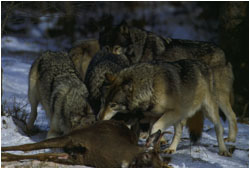 NOVA: Who has opposed the reintroduction of wolves and why?
NOVA: Who has opposed the reintroduction of wolves and why?EB: Well the livestock industry, particularly the sheep industry, has been the most outspoken opponent of wolf restoration. And the reason for that is obvious. I mean, sheep get killed by golden eagles, by mountain lions, by grizzly bears, black bears, feral dogs, coyote, you know, everything kills sheep. And so, of course, they don't want another predator feeding on their livestock. Cattle really don't get killed by much of anything—maybe a grizzly bear now and then. But wolves occasionally will kill livestock. The studies that we've done and that other people have done indicate that wolves normally kill less than one-tenth of one percent of the livestock available to them. To date, in the past 15 years in the northern Rocky Mountains, we've lost an average of about five cattle and five sheep per year to wolf depredations. And there is a private program that compensates producers for their losses. But still livestock producers have the potential to be the most directly impacted in a negative way by wolves. And so they've been the main opponent to wolf restoration. The supporters, of course, are people that own businesses around Yellowstone or Central Idaho who are selling wolf t-shirts and other tourists services. We did an economic analysis and it indicated that wolves in the Yellowstone system would generate up to about $19 million dollars a year in extra economic activity. So economically it's a big winner, but not for livestock producers. NOVA: Are livestock producers still fighting the reintroduction? EB: Well, I think everybody has accepted the fact that wolves are here to stay. The reintroductions are over and done with. The wolves are doing great. There's been almost no problems with livestock, and when there have been 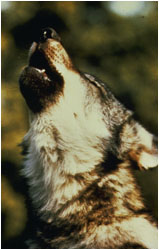 livestock problems, we efficiently take care of the problem including killing
the wolves, and they receive their money from the Defenders of Wildlife, a
group that established a private compensation program within just a matter of
weeks. So it's pretty hard to complain, really.
livestock problems, we efficiently take care of the problem including killing
the wolves, and they receive their money from the Defenders of Wildlife, a
group that established a private compensation program within just a matter of
weeks. So it's pretty hard to complain, really. NOVA: What changes have you seen in the ecosystem since the wolves arrived? EB: Wolves are a top-line predator. They have a major influence. It used to be that grizzly bears fed on elk carcasses only in the spring, when they became available. Now there's going to be a year-round supply of carcasses. So bears will have a more constant food supply throughout the year. Scavengers such as wolverines and bald eagles and golden eagles and magpies will also have carcasses throughout the year. And that's going to have an effect on the whole scavenger community. I predict that wolverines will become more common. One of the most interesting things to me is how, in the Lamarr Valley area of Yellowstone, the coyotes hang around the road now—the idea being that they need to get next to people, where the wolves spend less time. And we've actually had several coyotes killed by wolves. So I think wolves are impacting coyotes. And I would predict that within a few short years you're going to see a lot more of the animals that coyotes preyed upon, such as the smaller weasels, foxes, those kind of things. It will take time for the whole system to readjust, but already you can see the signs of it starting to change. Photos: (1,4) U.S. Fish and Wildlife Service; (2) USF&WS/Tracy Brooks; (3) USF&WS/LuRay Parker; (5) Animals Animals/© Robert Winslow; (6,12) USF&WS/David Meck; (7,9) Yellowstone National Park; (8) American Heritage Center, University of Wyoming, Guthrie Nicholson Collection; (10) USF&WS/John & Karen Hollingsworth; (11) Animals Animals/© Lynn M. Stone. What's in a Howl | Ed Bangs | Wolf-Dog Connection Resources | Guide | Transcript | Wolves Home Editor's Picks | Previous Sites | Join Us/E-mail | TV/Web Schedule About NOVA | Teachers | Site Map | Shop | Jobs | Search | To print PBS Online | NOVA Online | WGBH © | Updated November 2000 |